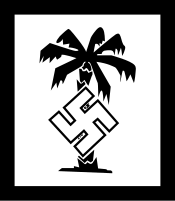Africa Korps
| Deutsches Afrikakorps | |
|---|---|

Three German officers confer together atop a tank in North Africa.
|
|
| Active | 12 February 1941 – 13 May 1943 |
| Country |
|
| Branch | Army |
| Type | Expeditionary force |
| Size | corps |
| Garrison/HQ | Tripoli, Italian Libya |
| Colors | Yellow, brown |
| Engagements | |
| Commanders | |
| Notable commanders |
Erwin Rommel Ludwig Crüwell Walther Nehring |
| Insignia | |
| Identification symbol |
 |
| Identification symbol |
Seal of the Deutsches Afrikakorps |
The Afrika Korps or German Africa Corps (German: Deutsches Afrikakorps, DAK ![]() listen ) was the German expeditionary force in Africa during the North African Campaign of World War II. First sent as a holding force to shore up the Italian defense of their African colonies, the formation fought on in Africa, under various appellations, from March 1941 until its surrender in May 1943. The unit's best known commander was Field Marshal Erwin Rommel.
listen ) was the German expeditionary force in Africa during the North African Campaign of World War II. First sent as a holding force to shore up the Italian defense of their African colonies, the formation fought on in Africa, under various appellations, from March 1941 until its surrender in May 1943. The unit's best known commander was Field Marshal Erwin Rommel.
The Afrika Korps formed on 11 January 1941 and one of Hitler's favorite generals, Erwin Rommel, was designated as commander on 11 February. Originally Hans von Funck was to have commanded it, but Hitler loathed von Funck, as he had been a personal staff officer of Werner von Fritsch until von Fritsch was dismissed in 1938.
The German Armed Forces High Command (Oberkommando der Wehrmacht, OKW) had decided to send a "blocking force" to Libya to support the Italian army. The Italian army group had been routed by the British Commonwealth Western Desert Force in Operation Compass (9 December 1940 – 9 February 1941). The German blocking force, commanded by Rommel, at first consisted of a force based only on Panzer Regiment 5, which was put together from the second regiment of the 3rd Panzer Division. These elements were organized into the 5th Light Division when they arrived in Africa from 10 February – 12 March 1941. In late April and into May, the 5th Light Division was joined by elements of 15th Panzer Division, transferred from Italy. At this time, the Afrika Korps consisted of the two divisions, and was subordinated to the Italian chain of command in Africa.
...
Wikipedia
